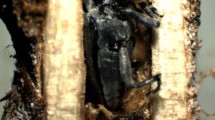Abstract
The psyllid insect (Heteropsylla cubana) is known to reduce biomass production in Leucaena species, but little information is available on the level of reduction, or whether a commonly used plant damage rating scale can be related to production losses. Biomass production losses due to predation by the psyllid were determined for 12accessions of Leucaena in a randomised split-plot field experiment conducted at Brisbane, Australia. Regrowthfrom well-established Leucaena trees, cut back to bare stems 50 cm high, was measured over a 9–week period from plants subjected to psyllid damage and from plants with psyllids controlled by spraying with chlorpyrifos (1 mg ai/l water). Psyllid damage was scored using a ratings scale developed by the University of Hawaii. Lossof potential DM production due to psyllids ranged from 10% for L. trichandra OFI53/88 to 76% for L. collinsii ssp. zacapana OFI56/88. Production losses were significantly correlated with psyllid damage ratings for 10 of the 12 accessions, and also for a combined data set comprising these 10 accessions. From correlations for the combined data set, a 50% loss of potential DM production occurred at a psyllid damage rating of approximately3.2. Results indicated that a “0” rating should be added to the scale to indicate the absence of psyllids.
Similar content being viewed by others
References
Austin M.T., Early R.J., Brewbaker J.L. and Sun W.1997. Yield,psyllid resistance, and phenolic concentration of Leucaena intwo environments in Hawaii.Agronomy Journal89: 507–515.
Austin M.P., Sorensson C.T., Brewbaker J.L., Sun W. and Shelton H.M.1995. Forage dry matter yields and psyllid resistance ofthirty-one leucaena selections in Hawaii.Agroforestry Systems31: 211–222.
Austin M.P., Williams M.J., Hammond A.C., Frank J.H. andChambliss C.G.1996. Psyllid population dynamics and plant resistance of Leucaena selections in Florida.Tropical Grasslands30: 223–228.
Bray R.A.1994. The Leucaena psyllid. In: Gutteridge R.C. andShelton H.M. (Eds.), Forage tree legumes in tropical agriculture.CAB International, Wallingford, UK, pp. 283–291.
Bray R.A. and Woodroffe T.D.1988. Resistance of some Leucaenaspecies to the leucaena psyllid.Tropical Grasslands22: 11–16.
Bray R.A. and Woodroffe T.D.1991. Effect of the leucaena psyllidon yield of Leucaena leucocephala cv Cunningham in south-eastQueensland.Tropical Grasslands25: 356–357.
Castillo A.C., Cuyagan O.C., Fogarty S. and Shelton H.M.1997.Growth, psyllid resistance and forage quality of Leucaena leucocephala, L. pallida, L. diversifolia and the F1 hybrid of L.leucocephala x L. pallida. Tropical Grasslands31: 188–200.
de Ponti O.M.B., Romanow L.R. and Berlinger M.J.1990. Whitefly-plant relationships: plant resistance. In: Gerling D. (Ed.),Whiteflies: their bionomics, pest status and management.Intercept Ltd. UK, pp. 91–105.
Hughes C.E.1998. Leucaena-A genetic resources handbook.Oxford Forestry Institute, Tropical Forestry Paper No. 37. Oxford,UK, 274pp.
Landsberg J.J.1977. Some useful equations for biological studies.Experimental Agriculture13: 273–286.
McNeill D.M., Osborne N., Komolong M. and Nankervis D.1998.Condensed tannins in the genus Leucaena and their nutritionalsignificance for ruminants. In: Shelton H.M., Gutteridge R.C.,Mullen B.F. and Bray R.A. (Eds.), Leucaena-adaptation, quality and farming systems. Proceedings of a workshop held in Hanoi, Vietnam 9–14 February 1998.ACIAR, Canberra, Australia.pp. 168–171.
Mullen B.F.2001. Agronomic adaptation to environmentalchallenges in the genus Leucaena.PhD Thesis. The Universityof Queensland, Brisbane, Australia.
Mullen B.F. and Dalzell S.A.1998. Phytotoxicity of insecticidesand wetting agents to the Leucaena genus. In: Shelton H.M.,Gutteridge R.C., Mullen B.F. and Bray R.A. (Eds.), Leucaena-adaptation, quality and farming systems. Proceedings of a workshop held in Hanoi, Vietnam 9–14 February 1998.ACIAR, Canberra, Australia. pp. 141–145.
Mullen B.F., Gabunada F., Shelton H.M. and Stür W.W.2003.Psyllid resistance in Leucaena. Part 1. Genetic resistance of thegenus in subtropical Australia and humid-tropical Philippines.Agroforestry Systems.
Palmer B., Bray R.A., Ibrahim T.M. and Fulloon M.G.1989. Theeffect of the Leucaena psyllid on the yield of Leucaena leucocephala cv. Cunningham at four sites in the tropics.TropicalGrasslands23: 105–107.
Queensland Agricultural College (QAC). 1992. Peskem.Department of Plant Protection, Queensland Agricultural College, Australia.
Wheeler R.A.1988. Leucaena psyllid trial at Waimanalo, Hawaii.Leucaena Research Reports8: 25–29.
Wheeler R.A. and Brewbaker J.L.1990. An evaluation of resultsfrom the Leucaena psyllid trial network.Leucaena Research Reports11: 23–31.
Wheeler R.A., Chaney W.R., Butler L.G. and Brewbaker J.L.1994.Condensed tannins in Leucaena and their relation to psyllid resistance.Agroforestry Systems26: 139–146.
Author information
Authors and Affiliations
Corresponding author
Rights and permissions
About this article
Cite this article
Mullen, B., Shelton, H. Psyllid resistance in Leucaena. Part 2. Quantification of production lossesfrom psyllid damage. Agroforestry Systems 58, 163–171 (2003). https://doi.org/10.1023/A:1026081307893
Issue Date:
DOI: https://doi.org/10.1023/A:1026081307893




